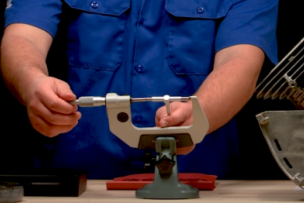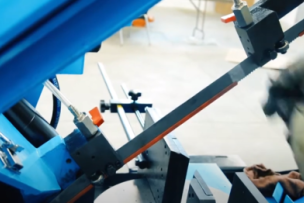Tips for Managing Thermal Loads in Milling Processes
The factors that generate thermal loads milling operations do not operate separately and are very complex.
Metal cutting generates a tremendous amount of heat. Temperatures in the cutting zone can reach up to 1500 to 1600 degrees Fahrenheit, and too high of temperatures can cause accelerated wear or deformation of the tool. Countering this challenge is significantly more difficult in milling operations due to interrupted cutting conditions causing the temperature of the cutting edges to rapidly rise and fall. If things get too hot, the tool or workpiece can be damaged, while cutting temperatures that are too low will not produce full cutting efficiency.
There are many individual elements that affect the generation, absorption and management of heat during the milling process. It’s important to understand how the choice of tooling and cutting parameters can minimize the impact of these elements in parts manufacturing.
Arc of engagement
The cutting teeth in milling generate heat for only a portion of the total machining time, with the cutter’s arc of engagement determining the amount. Radial cutting depth and cutter diameter influence the differing arcs of engagement in various milling processes.
In slot milling, the workpiece material surrounds half of the cutter during machining. The cutting edges spend half the machining time engaged in the cut and heat increases rapidly. With side milling, a relatively small percentage of the cutter is engaged in the workpiece at any one time, giving cutting edges a greater chance to dissipate heat to the air.
Absorption
All elements of the machining system absorb heat. Typically, 10 percent of the heat produced flows into the workpiece and 10 percent into the tool. The largest amount of heat – 80 percent – is absorbed into cut chips, which then carry it away from the work envelope. The thermal conductivity of the workpiece material directly influences heat distribution. For example, super alloys conduct heat poorly and result in an increased amount of heat transferring into the tool.
Chip thickness
Chip thickness affects tool life. If chips are too thick, the resulting heavy loads will generate excessive heat and chip or break the cutting edges. When chips are too thin, cutting occurs on a smaller portion of the cutting edge and increased friction and heat produce rapid wear.
The chips produced in milling continually change in thickness as the cutting edge enters and exits the workpiece, so machinists use the concept of “average chip thickness” to calculate cutter feed rates that will maintain required thicknesses.
Determining the correct feed rate involves multiple factors, including the cutter’s arc of engagement and the cutting edge angle. The greater the arc of engagement, the lower the feed rate required to generate the desired average chip thickness, and vice versa. Regarding cutting edge angle, maximum chip thickness occurs with a cutting edge angle of 90 degrees, so lesser cutting edge angles require a higher feed rate to achieve the same average chip thickness.
To maintain desired chip thickness and temperatures at the preferred levels, tool suppliers have developed compensation factors that call for increasing cutting speeds as the percentage of cutter engagement shrinks.
For example, if the speed factor for a fully engaged (100 percent of diameter in cut) cutter is 1.0, the speed compensation factor for a 90-degree cutting edge angle cutter with 20 percent of its diameter engaged in the cut is 1.35. Therefore, if the cutting speed for the fully engaged cutter is 100 m/min, the cutting speed needed to maintain optimal chip thickness for the cutter with only a fifth of its diameter in the cut is 135 m/min.
Cutting edge geometry
The basic geometries of the cutter and its teeth contribute to thermal load management. Cutters that position cutting edges at a positive rake produce lower cutting forces and generate less heat. However,
positive rake tools are weaker than negative tools. Sometimes workpiece material characteristics dictate the use of negative geometries which generate greater cutting forces and cutting temperatures.
Cutting edge geometries control both the cutting action and cutting forces, causing them to significantly impact heat generation. Chamfered or rounded edges are stronger but produce higher cutting forces and more heat. A sharp edge, while not quite as strong, reduces cutting forces and runs cooler.
Cooling
Using coolant may be effective in managing cutting temperatures in certain operations, though it can be extremely difficult to introduce into a high-temperature, high-pressure cutting zone where it evaporates instantly. Additionally, while it can be helpful when slot milling, it can cause cutting temperatures to remain too low in side milling applications.
The factors that generate thermal loads milling operations do not operate separately and are very complex.
- High temperatures can accelerate wear or deformation of a tool especially in milling.
- Due to interrupted cutting conditions, temperatures of the cutting edges rapidly rise and fall.
- The thermal conductivity of the workpiece material directly influences heat distribution.
Talk to Us!
Leave a reply
Your email address will not be published. Required fields are marked *


